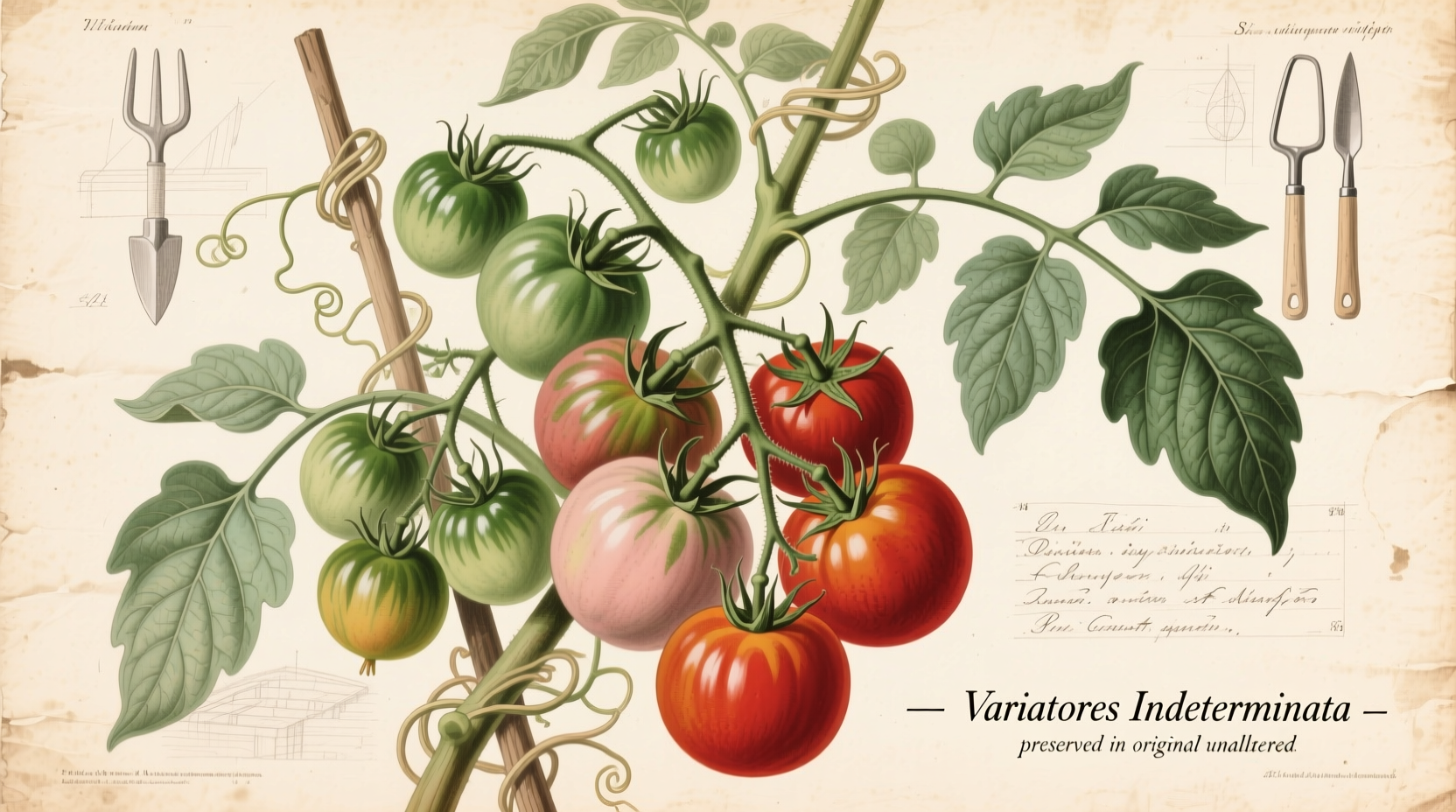Discover how to transform your garden with indeterminate tomato varieties that keep producing delicious, vine-ripened tomatoes all season long. Whether you're a beginner gardener or looking to optimize your harvest, this guide reveals the top-performing varieties, essential growing techniques, and proven strategies to maximize your tomato yield while avoiding common pitfalls.
Why Choose Indeterminate Tomatoes Over Determinate Varieties?
Understanding the fundamental difference between tomato growth habits is crucial for garden planning. Indeterminate varieties represent the classic "vining" tomato type that continues vertical growth and fruit production until frost. Unlike their bush-type determinate counterparts that ripen their entire crop within a 2-3 week window, indeterminate tomatoes provide a steady stream of fruit for 2-3 months when properly maintained.
| Characteristic | Indeterminate Tomatoes | Determinate Tomatoes |
|---|---|---|
| Growth Habit | Vining, continuous upward growth | Bush-type, stops at fixed height |
| Plant Height | 6-12 feet (requires strong support) | 3-4 feet (minimal support needed) |
| Harvest Period | Continuous from midsummer to frost | Concentrated 2-3 week harvest |
| Space Requirements | Significant (4-6 feet between plants) | Compact (2-3 feet between plants) |
| Best For | Fresh eating throughout season | Canning, sauces, container gardening |
Top Indeterminate Tomato Varieties for Every Garden Need
With hundreds of indeterminate varieties available, selecting the right ones depends on your specific gardening goals, climate, and culinary preferences. Research from the University of Minnesota Extension shows that matching varieties to your local conditions significantly improves success rates.
Best All-Purpose Slicing Tomatoes
'Better Boy' consistently ranks as one of the most reliable indeterminate varieties across diverse climates. This disease-resistant hybrid produces 10-12 ounce fruit with excellent crack resistance and delivers high yields from midsummer through fall. The Alabama Cooperative Extension System lists it among their top recommendations for home gardeners due to its exceptional productivity and disease resistance package (VFN).
'Big Beef' offers similar disease resistance with slightly larger fruit (12-16 ounces) and exceptional flavor that has made it a favorite among home gardeners. Its vigorous growth habit requires substantial support but rewards with continuous production of firm, flavorful tomatoes ideal for sandwiches and fresh eating.
Superior Heirloom Options
While heirlooms often present more growing challenges, certain indeterminate varieties deliver exceptional flavor worth the extra care. 'Brandywine' remains the gold standard for heirloom flavor, producing large (12-16 ounce), pinkish-red fruit with complex sweetness. According to University of Wisconsin Horticulture research, this variety performs best in cooler summer climates and requires consistent moisture to prevent cracking.
'Cherokee Purple' offers a unique flavor profile with earthy, smoky notes and beautiful dusky purple fruit. This Tennessee heirloom performs well in warmer climates but needs careful disease monitoring as it lacks modern disease resistance traits.
Essential Growing Requirements for Success
Indeterminate tomatoes aren't just taller versions of determinate varieties—they have distinct cultural requirements that must be met for optimal production. The Oregon State University Extension emphasizes that improper support systems account for nearly 40% of indeterminate tomato failures in home gardens.
Support Systems That Actually Work
Standard tomato cages quickly become inadequate for indeterminate varieties. Instead, implement one of these proven support methods:
- The Florida Weave: Install 7-foot stakes every 2-3 plants and weave twine horizontally between them as plants grow. This commercial method works exceptionally well for home gardens too.
- T-Frame Trellis: Build a sturdy overhead structure with crossbars at 5-6 feet height. Train main stems vertically and allow fruiting branches to hang down.
- String Suspension: Attach vertical strings from an overhead support to the base of each plant, gently twisting the plant around the string as it grows.

Pruning Techniques That Boost Production
Proper pruning directs energy toward fruit production rather than excessive foliage. Focus on these key techniques:
- Sucker removal: Pinch out side shoots (suckers) that form in leaf axils when they're 2-4 inches long. Most gardeners maintain 1-3 main stems.
- Bottom pruning: Remove leaves within 12 inches of soil to prevent soil-borne disease splash.
- Top pruning: In late season, remove growing tips to direct energy to ripening existing fruit before frost.
Avoiding Common Indeterminate Tomato Problems
Understanding the specific challenges of indeterminate varieties helps prevent disappointment. Unlike determinate types that complete their life cycle quickly, indeterminate plants face season-long challenges that require proactive management.
Disease Management Strategies
The extended growing season of indeterminate varieties increases exposure to fungal diseases. Implement these preventive measures:
- Water at soil level using drip irrigation or soaker hoses to keep foliage dry
- Apply 3-4 inches of organic mulch to prevent soil splash
- Rotate planting locations annually (minimum 3-year rotation)
- Choose varieties with disease resistance codes (look for V, F, N, T, A, ST)
Managing Late-Season Production
As fall approaches, indeterminate plants often have numerous green tomatoes that won't ripen before frost. The University of Maryland Extension recommends these techniques to maximize late-season harvest:
- Remove all new flowers and small fruit 4 weeks before first expected frost
- Cut back excessive foliage to improve air circulation and light penetration
- Reduce watering slightly to concentrate plant energy on ripening existing fruit
- Consider removing some green fruit to allow remaining tomatoes to ripen faster
When Indeterminate Varieties Might Not Be Right for You
Despite their advantages, indeterminate tomatoes aren't suitable for every gardening situation. Consider these limitations before committing garden space:
- Container gardeners with limited space (typically need 15+ gallon containers)
- Gardeners seeking a single large harvest for canning or sauce making
- Those with physical limitations that make tall plant maintenance difficult
- Gardens with less than 6 hours of daily sunlight (indeterminates need 8+ hours)
For these situations, determinate varieties or compact "patio" indeterminate types like 'Patio Princess' may provide better results. The key is matching your tomato selection to your specific gardening context and goals.











 浙公网安备
33010002000092号
浙公网安备
33010002000092号 浙B2-20120091-4
浙B2-20120091-4